Ductless silent fans for hoods: existing types of devices and their operating parameters
Modern ventilation equipment is able to provide a healthy microclimate in any room. But often this is achieved to the detriment of the comfort of living, as the noise associated with work causes at least discomfort and irritability, and even chronic fatigue.
Exit the situation will help channel silent fans for hoods. We will talk about how to correctly select an extremely quiet device designed for installation in an exhaust duct or a hole drilled in a wall. We will show you how to understand the assortment taking into account the characteristics and features of the work.
The content of the article:
Features and characteristics of equipment
Silent channel fans on the market are traditionally divided into different categories, subspecies. But a healthy microclimate for the most part depends on performance. One of which, noiselessness, is even put into the name, that is, the buyer always needs to make a choice by defining a number of parameters.
The main ones are:
- noiselessness;
- performance.
If you like silence, then you need to start the search with the first characteristic, since it is it that has a significant impact on the comfort of living.
Instrument noise criterion
According to sanitary standards SN 2.2.4 / 2.1.8.562-96, in residential premises and a number of others, the noise level should not exceed moderate 30 dB in the daytime and 20 dB in the night. Which are comparable to a quiet whisper and in many situations will be quite appropriate for kitchens, bathrooms and other rooms.
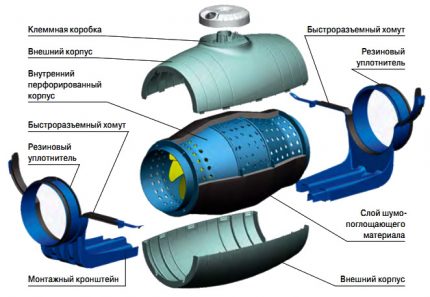
But still you need to remember that often the sound emitted by these fans at 30-35 dB even from a distance of several meters will annoy users. This is especially true for situations where next to the toilet or bathtub, equipped with ventilation equipment is a bedroom, a nursery.
As a result, you should be aware that it is truly silent, and without any compromises and tricks by marketers, models are considered which have such a performance that does not exceed 25 dB. In this case, the sound of the fan running is comparable to a very quiet whisper.
Since the good is always the enemy of the best, when buying, you need to remember that the models that belong to the category of market leaders by noiselessness produce no more than 20-22 dB.
And although the advantage over conventional low-noise models may seem insignificant, but it may well become decisive after several years of operation. Those. when the performance of the device decreases, bearings begin to develop, the air ducts become clogged with dust, and the anti-noise gaskets wear out.
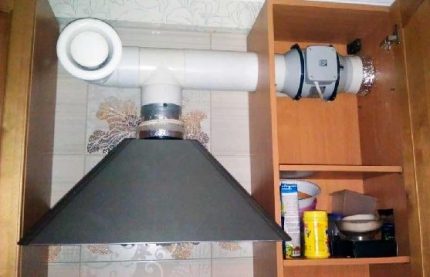
A comfortable sound of working ventilation equipment can provide a number of integrated solutions of engineers.
These include the following:
- use of high precision bearings - such high-quality and balanced products exclude beating, as a result of which there will be no vibration, which resonating can significantly enhance the sound;
- high technology blades - one of the reasons for the noise is the aerodynamic component, so the developers, wanting to make the sound comfortable, carefully select the number of blades, the optimal tilt angles, as well as in the manufacture of the exact balancing of the impeller elements;
- use of technological buildings - high-quality manufacturing material (metal, plastic) eliminates the vibration of individual parts and assemblies, aerodynamic noise of moving air;
- using vibration damping pads - quiet operation is also achieved by using special types of rubber as gaskets to prevent contact between the housing itself and the attachment points of the electric motor to it.
Gaskets have become an important structural element, they isolate the fan casing from the duct, wall.
Bearings, blades and special housings and gaskets - all this reduces to insignificant values vibration, turbulence of air flows and their resonance.
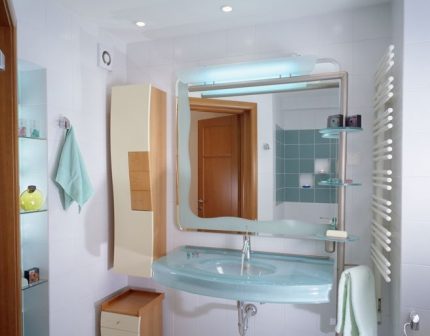
Today, it is not uncommon to finish ventilation shafts with modern soundproof materials. Reduces noise and reliable mounting of the motor to the housing. The power plants themselves are conventional and are used on all types of fans.
Fan performance
This characteristic is considered one of the most important, as it is interconnected with noise. It is clear that the higher the performance, the louder the electric motor and related sounds.
As a result, mindlessly buy exhaust fan in the bathroom, to the kitchen, to the toilet on the principle “you can't spoil the porridge with butter” is not worth it, as this can result in a decrease in the comfort of living and financial loss.
But avoiding the negative consequences is easy. That is, the optimal power can be calculated, knowing that such an indicator should correspond to the derivative of the volume of the room and the rate of air exchange.
For example, the shower volume is 5 m³, and the recommended air exchange rate, according to SNiP, 7-9. And to calculate the productivity you just need to multiply cubic meters by any number of multiplicity. The result is 35-45 m³ / hour.
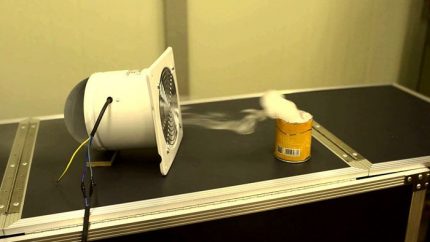
Various types of fans perform a number of important options. Therefore, so that during operation you do not have any problems with the device, you should pay attention to a number of characteristics when buying.
Which, in any situation, include:
- construction safety;
- functionality;
- geometric dimensions;
- cost.
Although all of these features are traditionally in the shadow of the main performance characteristics (performance, noise), but they cannot be called secondary. Since each of them significantly affects the features of ventilation equipment.
The Importance of Safe Design
Since channel-type fans are designed for ventilation in all kinds of rooms, they often have to work in difficult conditions. Which create increased humidity in the bathroom, kitchen, toilet, the presence of particles of fat in places of cooking and increased dustiness in other rooms.
All of the above has a significant impact on the performance, durability of the unit. And most importantly affects the safety of living. Since particles of moisture and fat can always lead to short circuits and other negative consequences.
Every used silent fan It must be at least splash-proof, and even better waterproof. An effective measure that allows you to take care of your health is to purchase a unit that works from low voltage, which is considered 24 V, but its power will not be enough in all cases.
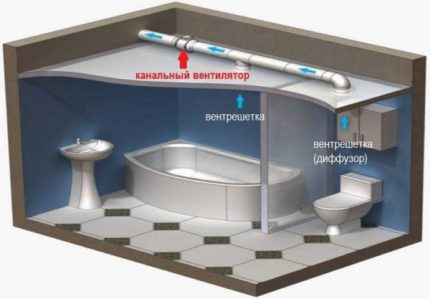
And the most practical solution is to buy a fan with a protection class of at least IP34. Since as a result, the user will protect himself, his family from all kinds of unpleasant cases.
The value of the functionality of the equipment
Modern duct fans designed for hoods in the bathroom or in the kitchen, it’s quite technological and the buyer has the right to choose a device with the most suitable operating mode, which can be:
- standard;
- auto;
- autonomous.
In the first case exhaust fan connected to the same electricity switch as the lighting of the room in which it is installed. As a result, both lamps and ventilation equipment are turned on simultaneously.
The shutdown procedure occurs in the reverse order, that is, after shutdown, the ventilation and lighting of the room cease.
The method described above is quite convenient and effective for use in combined bathroombut already considered obsolete. The reason is that short ventilation cycles are not able to successfully cope with high humidity, for example, in the bathroom.
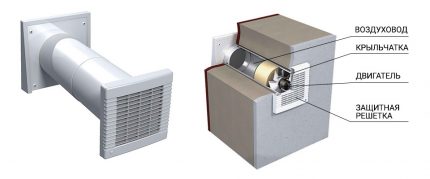
Some species exhaust appliances can work autonomously, determining the level of pollution independently. Less technologically advanced fans operate on the basis of the programs laid down in their timers, while the simplest products are ventilated between the on / off switches that the user carries out.
This feature does not allow you to effectively deal with the replacement of air masses with fresh ones or leads to an excessive consumption of electricity, and an impressive one.The automatic ventilation option means that the fan has a timer that allows you to set the ventilation period taking into account the conditions in a particular room.
As a result, the procedure is as follows:
- The user, entering the bathroom or any other room with a fan, turns it on by pressing the switch button.
- A ventilation device discharges contaminated air masses, even after a person leaves the room.
- The stop occurs automatically after the user-defined time period has elapsed.
The advantage of this type of equipment is the ability to choose the optimal mode for all cases. At the same time, user participation in the work is minimal.
The most modern are duct fans, capable of air exchange in standalone mode. That allows you to make the presence of sensors (for example, humidity). The signal from which turns on / off the fan itself.
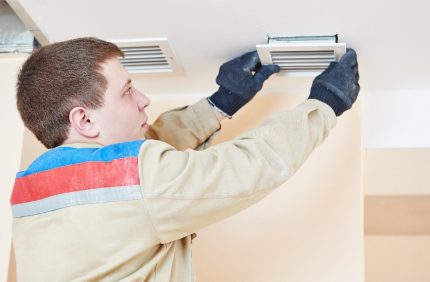
The advantage of the latter method is the greatest efficiency. That is, the air is always clean, while user involvement is not required, it is also important that there is no excessive consumption of electricity.
Shape, size and cost
Today, fans with various shapes are available for sale.
Which are:
- round;
- rectangular;
- square.
But you should know that for domestic purposes, mainly products related to the first variety are used.
Rectangular and square analogs are most often ranked as productive industrial devices, so the owner of a house, apartment, office is unlikely to have to deal with them. The only exceptions are cases when a vertical ventilation pipe is used in the form of a separate duct.
The main geometric parameter of domestic duct fans is the installation size. For example, the specified characteristic is always indicated on the body ventilation device and in its technical documentation, as it is quite capable of affecting performance.
In addition, the indicated dimensions are a standard value, which facilitates the selection of a fan.
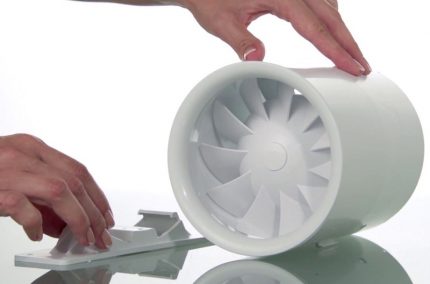
Therefore, you should know that for domestic purposes, the optimal devices are those on which there is a marking of 100, 125 or 150 mm. For ventilation in non-standard large residential premises, restaurants, offices, options are indicated on which 160 mm or 200 mm are indicated. Large items are industrial.
Since the performance, the functionality of the fans, the quality of the materials of manufacture and the amount of work that ensures noiselessness are radically different, their price is significantly different.
As a result, a fairly moderate amount will have to be paid for an inexpensive option. And for a model capable of working autonomously, that is, equipped with a humidity sensor, a controller and capable of acting guaranteed to be silent for many years, you need to pay several times more.
For comparison: for the money you can buy a very decent smartphone. However, the most affordable fans are not the best option. After all, they are not designed for a high level of security, durability.
Types of duct fans
Today at the point of sale you can find fans that are structurally related to several varieties.
These include:
- axial, less often they are called axial;
- radial;
- centrifugal.
Each species has its advantages and disadvantages, so they should be known.
Group # 1 - axial fans
A characteristic feature of this variety is the direction of air flows along the axis of the electric motor, on which the impeller is located, which is responsible for the movement of air masses.
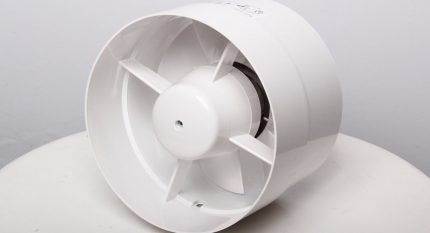
The main advantages of axial fans for all kinds of hoods are:
- low productivity required to move air masses;
- economical electric motor;
- simple construction.
These features make the units related to the presented species, the most silent without any additional measures. That allows them to be ranked among the most affordable, and therefore demanded for any domestic needs.
The main disadvantage is low productivity, which is still quite enough to solve various local problems.
Group # 2 - radial fans
Such devices are more technologically advanced than the axial ones described above. This is evidenced by the fact that the air flows do not move directly along the axis, but due to the special shapes of the impeller blades, they are mixed, compressed and sent to the housing.
In this case, a vacuum effect is created behind the trailing edges. This leads to the fact that there is a rapid absorption of external air flows.
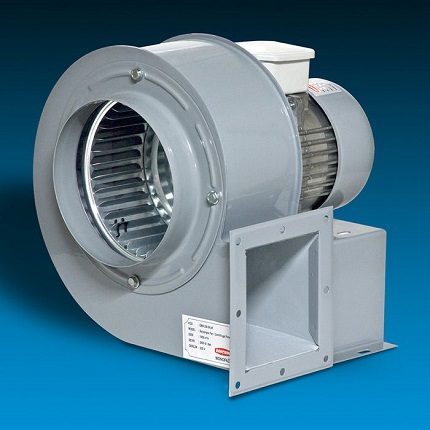
So, the radial type of fan designed for hoods is of two types:
- with shoulder blades inclined forward;
- with shoulder blades tilted back.
Optimal for silent operation is the first variety, moreover, it is more economical, with an impressive 20%. But if performance is an important parameter, then it is better to purchase fans whose blades are tilted back.
An important feature of each radial fan for any type of hood is compact. This advantage is especially valuable when the installation space is hard to reach or not enough.
Group # 3 - centrifugal fans
This is the most modern, most silent and productive type of duct fans. Their principle of operation is similar to radial counterparts. That is, closer to the body, increased pressure is created, and in the center a discharged space, which leads to more efficient absorption of external air masses.
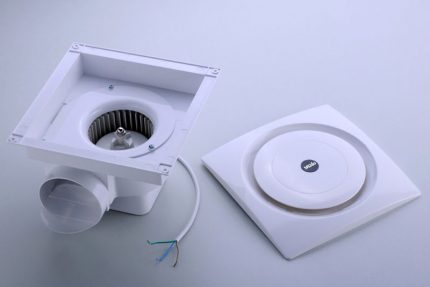
Design features and operating principle makes centrifugal fans the quietest. In addition, they can be installed directly in the ventilation shaft of the apartment, which eliminates the negative impact on the aesthetic properties of the room.
And most importantly, this helps to increase the power of units of this type and reduce the impact of moisture and dust on them, which extends the life.
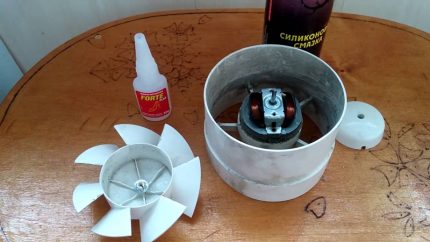
A significant disadvantage of any centrifugal fan is its high performance, as a result of which they can be used only in rooms from 15 m².
Conclusions and useful video on the topic
This video material makes it possible to get acquainted with what a channel fan is and understand the principle of its operation:
Among modern channel fans it is quite feasible to find a noiseless model of the required power, characterized by durability and safety, and in various price categories. But at the same time you should own a certain store of knowledge or you can’t get the expected result.
Want to talk about how you chose a silent fan for installation in an exhaust duct? Share what you personally has become the main selection criterion. Please leave comments in the block below, ask questions and post questions on the topic of the article in the block below.

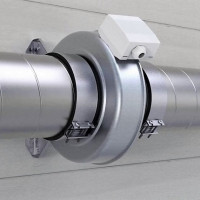 The best channel fans: TOP-15 popular devices + recommendations to potential buyers
The best channel fans: TOP-15 popular devices + recommendations to potential buyers 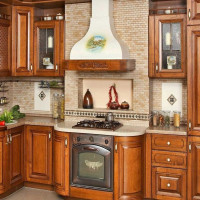 Plastic ventilation pipes for hoods: types, their characteristics, application
Plastic ventilation pipes for hoods: types, their characteristics, application 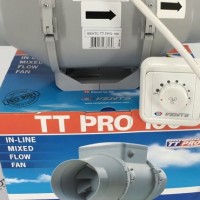 Channel fan speed adjustment: connecting the controller and adjusting the exhaust speed
Channel fan speed adjustment: connecting the controller and adjusting the exhaust speed  Silent humidifiers for the home: TOP-10 rating of the quietest units
Silent humidifiers for the home: TOP-10 rating of the quietest units 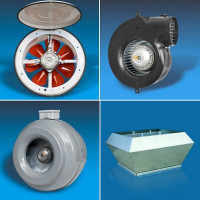 Types of fans: classification, purpose and principle of their operation
Types of fans: classification, purpose and principle of their operation 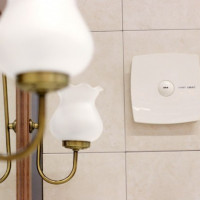 How to disassemble the exhaust fan in the bathroom: instructions for disassembling and cleaning the exhaust fan
How to disassemble the exhaust fan in the bathroom: instructions for disassembling and cleaning the exhaust fan  How much does it cost to connect gas to a private house: the price of organizing gas supply
How much does it cost to connect gas to a private house: the price of organizing gas supply  The best washing machines with dryer: model rating and customer tips
The best washing machines with dryer: model rating and customer tips  What is the color temperature of light and the nuances of choosing the temperature of the lamps to suit your needs
What is the color temperature of light and the nuances of choosing the temperature of the lamps to suit your needs  Replacement of a geyser in an apartment: replacement paperwork + basic norms and requirements
Replacement of a geyser in an apartment: replacement paperwork + basic norms and requirements
We bought a house in which there is a large basement with brick walls, it is very well finished, but there is no ventilation in it and this causes condensation to drop on the ceiling in the hot season. I liked how the different types of fans are described. I would like to ask which one is suitable for the basement and in what place is it best to install it?
First of all, you need to calculate the minimum section of the ventilation channel for the cellar, based on the total area of the basement. In accordance with this, select the fan of the required power. I can not advise you on a specific model of the channel fan, since I do not have any input data.
I enclose the simplest air exchange scheme in the cellar, which you can focus on. And a bonus photo of the outlet of the duct, implemented in my basement. Where it is more convenient and practical to install ventilation you decide for yourself, based on the layout.